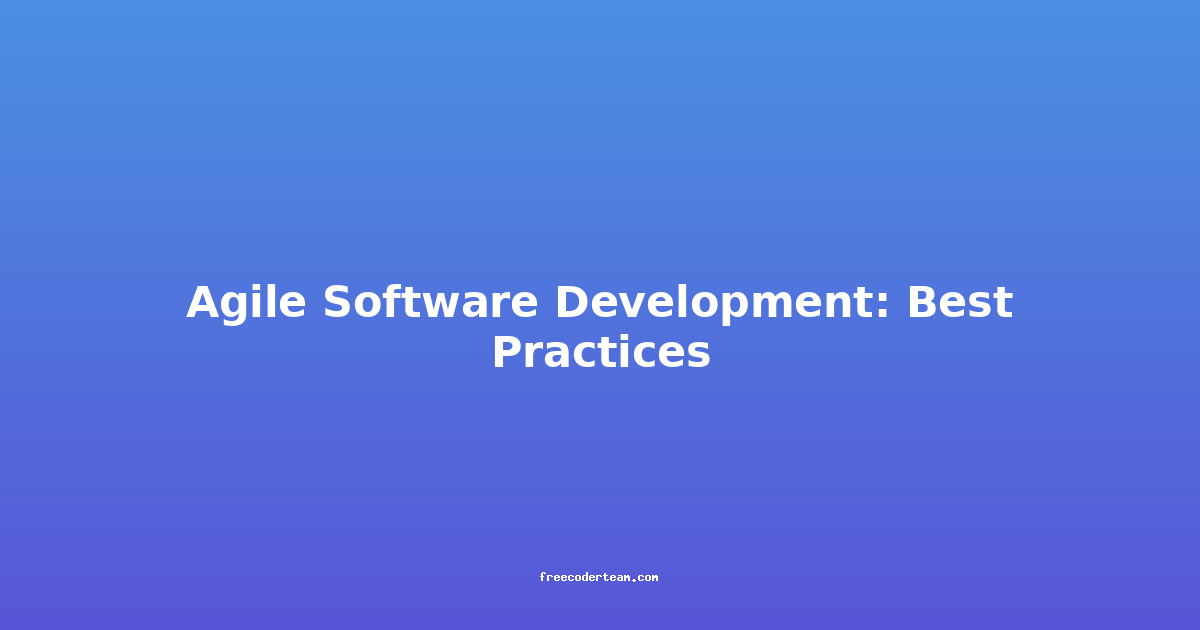Agile Software Development: Best Practices
Agile software development has revolutionized the way teams build and deliver software. It emphasizes flexibility, collaboration, and rapid iteration, allowing teams to adapt to changing requirements and deliver value more efficiently. In this blog post, we'll explore the key principles of Agile, discuss best practices, and provide actionable insights to help teams implement Agile effectively.
Understanding Agile Software Development
Agile is a methodology that emerged as a response to the rigidity of traditional waterfall approaches. It is based on the Agile Manifesto, which prioritizes:
- Individuals and interactions over processes and tools.
- Working software over comprehensive documentation.
- Customer collaboration over contract negotiation.
- Responding to change over following a plan.
Agile methodologies, such as Scrum, Kanban, and Lean, provide frameworks to implement these principles. The goal is to deliver high-quality software incrementally, allowing teams to adapt to feedback and market changes quickly.
Best Practices in Agile Software Development
1. Embrace Iterative Development
Agile thrives on iterative development. Instead of delivering a complete product at the end of a long cycle, Agile teams break work into small, manageable chunks called sprints (typically 1-4 weeks long). Each sprint produces a functional increment of the product.
Practical Example: Sprint Planning
A team is building a new e-commerce platform. Instead of spending months building the entire platform, they break the work into sprints. The first sprint might focus on creating a basic login and registration system. The second sprint could add cart functionality, and subsequent sprints could focus on shipping, payment integration, and more.
| Sprint | Duration | Objective |
|--------|----------|-----------|
| 1 | 2 weeks | Basic login and registration |
| 2 | 2 weeks | Add shopping cart functionality |
| 3 | 2 weeks | Implement payment gateway |
| 4 | 2 weeks | Add shipping options |
Actionable Insight:
- Define sprint goals clearly. Each sprint should have a specific, achievable goal that adds value to the product.
- Use a backlog. Maintain a prioritized list of tasks (product backlog) that can be broken down into sprint-specific tasks (sprint backlog).
2. Prioritize Regular Feedback and Collaboration
Agile is inherently collaborative. Teams work closely with stakeholders, including customers, to gather feedback throughout the development process. This ensures that the final product meets user expectations.
Practical Example: Daily Stand-ups
Daily stand-up meetings (also called scrum meetings) are a core part of Agile. These short, 15-minute meetings allow team members to:
- Share what they worked on the previous day.
- Discuss what they plan to work on today.
- Identify any blockers or challenges.
Example of a Stand-up:
- Developer 1: "Yesterday, I completed the login feature. Today, I'll work on adding validation for email addresses. No blockers."
- QA Engineer: "Yesterday, I tested the registration form and found a bug. Today, I'll test the login feature. No blockers."
- Product Owner: "Yesterday, I met with the client to review the registration form. Today, I'll work on prioritizing the next sprint tasks. Blocker: Need clarification on payment gateway requirements."
Actionable Insight:
- Encourage open communication. Ensure that everyone feels comfortable sharing updates, challenges, and ideas.
- Involve stakeholders. Regularly invite stakeholders to demos or reviews to gather feedback.
3. Implement Continuous Integration and Continuous Deployment (CI/CD)
CI/CD is a practice where code changes are automatically built, tested, and deployed to production. This ensures that the software is always in a deployable state and reduces the risk of errors.
Practical Example: CI/CD Pipeline
Suppose a team is working on a web application. Their CI/CD pipeline might look like this:
- Code is committed to the repository.
- Automated tests are run.
- If tests pass, the code is deployed to a staging environment.
- Automated smoke tests are performed on the staging environment.
- If smoke tests pass, the code is deployed to production.
Code Commit → CI Server → Automated Tests → Staging Deployment → Smoke Tests → Production Deployment
Actionable Insight:
- Set up automated tests. Write unit tests, integration tests, and end-to-end tests to ensure code stability.
- Automate deployments. Use tools like Jenkins, GitLab CI, or GitHub Actions to automate the deployment process.
4. Focus on Cross-Functional Teams
Agile teams are self-organizing and cross-functional, meaning they have all the skills needed to deliver a product increment. This reduces dependency on external teams and speeds up decision-making.
Practical Example: Cross-Functional Team Structure
A typical Agile team might include:
- Product Owner: Manages the product backlog and ensures the team is working on the highest-priority features.
- Scrum Master: Facilitates the Agile process and helps the team stay on track.
- Developers: Build the software.
- QA Engineers: Test the software to ensure quality.
- UI/UX Designers: Design the user interface and user experience.
- Business Analysts: Translate business requirements into technical specifications.
Actionable Insight:
- Promote collaboration. Encourage team members to work together and share knowledge.
- Empower the team. Trust the team to make decisions about how to implement features.
5. Monitor and Adapt Using Metrics
Agile teams use metrics to measure progress and identify areas for improvement. Common metrics include:
- Velocity: The amount of work a team can complete in a sprint.
- Burndown Chart: Tracks the remaining work versus the time left in the sprint.
- Lead Time: The time it takes to complete a user story from start to finish.
Practical Example: Burndown Chart
A burndown chart visually represents the work remaining in a sprint. The x-axis shows the days of the sprint, and the y-axis shows the remaining work (in story points or hours). A downward trend indicates progress.
Day 0 Day 1 Day 2 Day 3 Day 4 Day 5
|-------|-------|-------|-------|-------|-------|
| | | | | | |
| | | | | | |
| | | | | | |
|-------|-------|-------|-------|-------|-------|
Actionable Insight:
- Use metrics for insights, not judgment. Metrics should help teams identify bottlenecks and improve processes, not penalize individuals.
- Regularly review metrics. Hold sprint retrospectives to discuss what went well and what can be improved.
6. Emphasize Continuous Learning and Improvement
Agile teams are continuously learning and adapting. The retrospective is a key part of this process. At the end of each sprint, the team reflects on what went well, what didn't, and how they can improve.
Practical Example: Sprint Retrospective
At the end of a sprint, the team might discuss:
- What went well: "We had a smooth deployment process due to our CI/CD pipeline."
- What didn't go well: "We spent too much time on a feature due to unclear requirements."
- What can be improved: "We need clearer communication with the product owner to avoid misunderstandings."
Actionable Insight:
- Encourage a culture of learning. Treat mistakes as opportunities to learn and improve.
- Implement action items. After each retrospective, assign actionable items to team members to address identified issues.
Tools and Technologies for Agile
To implement Agile effectively, teams often use tools that support the methodology. Some popular tools include:
- Jira: For managing sprints, backlogs, and tracking progress.
- Trello: A simple, visual tool for managing tasks using Kanban boards.
- Visual Studio Team Services (Azure DevOps): For CI/CD pipelines and Agile project management.
- Slack: For real-time communication and collaboration.
- Git/GitHub: For version control and code management.
Practical Example: Using Jira for Sprint Management
Jira allows teams to:
- Create and manage sprints.
- Track progress using boards and burndown charts.
- Assign tasks to team members.
- Integrate with CI/CD tools for automated deployments.
Actionable Insight:
- Choose tools that fit your team's needs. Not all tools are one-size-fits-all. Evaluate what works best for your team's size and workflow.
- Train your team. Ensure team members are comfortable using the tools to avoid roadblocks.
Overcoming Common Agile Challenges
While Agile offers many benefits, teams often face challenges, such as:
- Resistance to change. Teams accustomed to traditional methodologies may resist Agile's collaborative and iterative approach.
- Lack of clear communication. Without effective communication, teams may misunderstand requirements or priorities.
- Scope creep. Constant changes in requirements can lead to scope creep, delaying delivery.
Practical Example: Managing Scope Creep
To avoid scope creep:
- Clearly define sprint goals. Ensure that each sprint has a well-defined scope.
- Prioritize the product backlog. Focus on high-priority items and avoid low-priority features.
- Involve stakeholders in sprint planning. Ensure that all parties agree on the sprint goals.
Actionable Insight:
- Be transparent. Communicate regularly with stakeholders about progress and any changes in scope.
- Adopt a flexible mindset. While Agile is adaptable, it's important to maintain focus on the highest-priority features.
Conclusion
Agile software development is a powerful methodology that empowers teams to deliver high-quality software efficiently. By embracing iterative development, prioritizing feedback, and fostering collaboration, teams can build products that meet user needs and adapt to changing requirements.
To implement Agile effectively, teams should:
- Focus on iterative development and regular feedback.
- Use CI/CD to ensure code is always deployable.
- Build cross-functional teams that can deliver complete product increments.
- Monitor progress using metrics and adapt based on insights.
- Foster a culture of continuous learning and improvement.
Agile is not just a set of practices; it's a mindset. By embracing these best practices, teams can achieve higher productivity, better quality, and greater customer satisfaction.
References:
Feel free to reach out if you have any questions or need further clarification! 🚀
Stay Agile, Stay Productive! 📊




